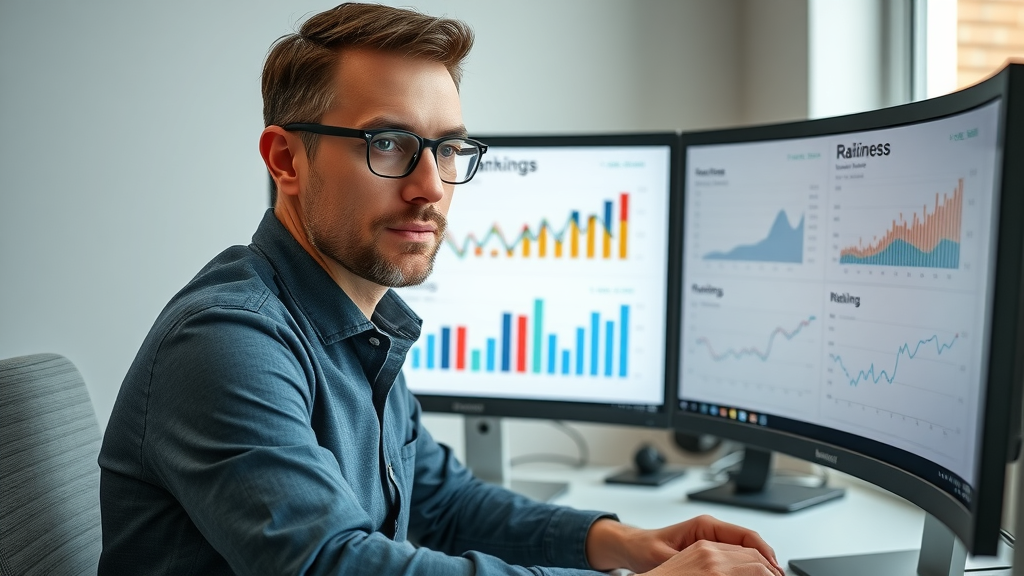Did you know that 97% of people discover more about a local business online than anywhere else? For any business owner wanting to thrive locally, the small map pin on a Google search is now your most powerful marketing tool. In today’s digital-first world, Google My Business optimization is the make-or-break factor for attracting new customers and standing out amidst crowded search results. This guide demystifies the step-by-step process of optimizing your profile, ranking higher on local search, and turning online searches into real-world revenue.

Unlocking Growth: The Impact of Google My Business Optimization on Local Search
Businesses that master google my business optimization enjoy powerful advantages in the ever-evolving digital landscape. When your business profile is fully optimized, it unlocks premium placement on the results page—putting your products and services right in front of people searching for what you offer. Whether you're competing on a crowded city block or reaching shoppers researching from their phones, a well-optimized profile is essential for attracting foot traffic and converting online interest into loyal customers. Harnessing this tool isn’t just about visibility; it’s about establishing trust in the local search ecosystem, where every positive interaction counts toward your reputation.
Consider how local search has transformed customer behavior: shoppers rarely browse long business lists or phone books. Instead, they rely on business profiles that deliver what they’re looking for instantly—clear contact information, up-to-date business hours, and genuine customer reviews. Investing just a few hours into optimizing your Google business profile can result in months (or years) of increased calls, direction requests, and website visits—all metrics directly influencing your bottom line. By prioritizing robust business information and actively engaging with reviews, you set your business up to rank higher in local searches and appear more reputable in the eyes of both Google’s algorithm and potential customers.
- Discover why 97% of people learn more about a local company online than anywhere else.
"Businesses with optimized Google business profiles are twice as likely to be considered reputable by customers." — Local Search Association

What You Will Learn in This Guide on Google My Business Optimization
- Understand the fundamentals of google my business optimization
- Master local search ranking factors
- Step-by-step process to optimize your Google business profile
- Key strategies to continuously improve your google business presence
- Proven tips to rank higher on local search and Google Maps
The Fundamentals of Google My Business Optimization
What is Google My Business Optimization?
Google My Business optimization is the ongoing process of refining your business profile to maximize visibility and results in local search. This means every critical field—from business hours and contact information to business info and product photos—must be accurate, engaging, and consistently maintained. By optimizing your Google business profile, you make it easier for potential customers to discover you across Google Maps, search engine results pages, and mobile searches, enhancing both online and in-person engagement.
Unlike other business directories, Google My Business is fully integrated with Google’s powerful search and maps platforms. This integration lets you showcase your business profile directly in search results when a potential customer is researching products or services you offer. Optimization isn’t a one-time project but rather an ongoing discipline. It involves regularly refreshing your offerings, gathering and responding to customer reviews, updating images, and staying in touch with your audience through posts and Q&As. This dynamic approach helps you rank higher and outperform competitors in local searches.
| Feature | Before Optimization | After Optimization |
|---|---|---|
| Visibility | Low; not always shown in top search results | High; shows up prominently in Google Maps and local search results |
| Interactions | Few or no customer reviews, outdated info, poor engagement | Active engagement, consistent responses to reviews, current info |
| Local Search Traffic | Minimal website visits and direction requests | Significant increase in calls, messages, website visits, and check-ins |
How Does Google My Business Optimization Affect Local Search?
The way you approach optimizing your Google business profile directly influences how Google presents your company in local search results. Factors such as NAP (Name, Address, Phone number) consistency, keyword relevance in your business description, and the frequency of customer reviews all determine your profile’s local search ranking. When a potential customer performs a local search, Google surfaces the most relevant and authoritative business profiles—giving optimized businesses a crucial advantage on the search results page.
Optimized profiles also see higher interaction rates. For example, profiles rich with photos and timely business info attract more clicks, direction requests, and phone calls than those with generic or incomplete information. By leveraging posts, events, and Q&A, businesses can engage directly with local audiences, influencing how likely Google is to display them for relevant queries. Remember, local SEO through Google My Business is a dynamic process—measuring success, analyzing analytics, and refining strategies must happen continuously for sustained visibility.

Google Business Profiles vs. Traditional Business Directories
Traditional business directories once served as a primary resource for discovering local businesses. However, with the advent of Google business profiles , the landscape has shifted dramatically. Unlike static business lists, Google My Business provides an interactive, up-to-date interface for potential customers to find business information instantly. Integration with Google Maps ensures seamless navigation, and the visibility of up-to-the-minute posts, reviews, and photos positions your company as responsive and trustworthy in the digital world.
Another distinct advantage of Google business profiles is their role in building social proof. Verified reviews, updated contact information, and relevant business hours establish your legitimacy far more effectively than a traditional directory entry. With real-time analytics, businesses can monitor what works, experiment with posts and promotions, and swiftly respond to customer feedback—advantages that are simply unavailable with legacy directories. By prioritizing Google My Business optimization, you ensure your profile stands out in a competitive digital market.
Case Examples: Local Businesses Before and After Google My Business Optimization
Consider a local bakery that previously relied on word-of-mouth and a static business listing. After optimizing their Google My Business profile —adding fresh product photos, updating business hours, and encouraging customer reviews—they saw a 40% increase in foot traffic during the morning rush. Their business now appears in “best breakfast near me” results, thanks to targeted keywords in their business info and regular posts with new menu items.
Another example: a neighborhood gym with outdated contact information and infrequent updates languished low in local search results. Through GMB optimization—which included consistent NAP data, frequent photo uploads, and prompt responses to customer questions—the gym not only climbed to the top of search results but attracted new memberships through mobile searches and Google Maps. This instant visibility demonstrates how strategic optimization directly translates to revenue.

Step-By-Step Guide: How to Optimize Your Google My Business Profile for Maximum Impact
Setting Up and Verifying Your Google Business Profile
- Claim your Google business listing accurately
- Verify ownership promptly
- Enable notifications for profile updates
The journey to effective google my business optimization begins with claiming your Google business listing. This one-time step establishes your authority as an owner or manager, giving you full control over your business info, photos, and updates. Immediately after claiming, complete the verification process—whether by mail, phone, or email. Verified profiles gain more visibility and trust, ensuring only authoritative business information appears in local search and on Google Maps. Once verified, enable notifications so that you’re alerted instantly to reviews, Q&As, or changes, allowing you to respond promptly and keep your business profile dynamic.

Filling In Key Business Information and Contact Information
- Enter correct business info (name, business hours, location)
- Include accurate phone number and address
- Add service areas for increased reach
Google rewards complete and accurate business information . Make sure your company name, address, and phone number (NAP consistency) exactly match what’s displayed on your website and other directories—any mismatch can confuse Google and lower your ranking in local search results. Set regular business hours and update them for holidays, ensuring that customers never arrive to find your doors unexpectedly closed. List service areas if your business serves beyond a physical location, making it easier to appear in search results for adjacent neighborhoods or cities. The more information you provide in your business profile—such as accepted payment types and accessibility features—the better your chances to convert potential customers browsing online into loyal clientele.
Optimizing Your Google Business for Local Search
- Use local keywords in descriptions
- Select relevant business categories
- Implement NAP consistency
For superior local SEO , fill every descriptive field in your profile with natural, local keywords. For example, mention the neighborhood, city, and products or services you specialize in (“family-owned East Austin café,” for example). Select all relevant business categories—both primary and secondary—to help Google match your business to more types of searches. Maintain NAP consistency everywhere your company is listed online, as search engines use this as a trust signal for ranking higher in search results. Don’t overlook the Q&A section: answering common customer questions in advance not only improves experience, but can help boost conversions and signal your expertise to Google’s algorithms.
Enhancing Your Google My Business Profile with Products and Services
- Showcase primary services and most popular products
- Add detailed descriptions, menus, or service lists
- Use images for each product/service
Highlighting your most popular products and services sets your business apart on the search results page . Use high-quality images, concise but engaging descriptions, and clear pricing whenever possible. Specific product and service listings make it easier for potential customers to find exactly what they’re after, including through Google Maps and voice search. Consider uploading full menus, service brochures, or promotional offers directly to your profile so that browsing customers can view your selections instantly, driving more decisions and increasing conversion rates.

Maintaining Updated Business Hours and Service Availability
- Update business hours for holidays and special occasions
- Utilize Google Posts for important updates
- Enable messaging for customer convenience
Committed to optimizing your Google business profile ? Don’t let your business hours go stale. Proactively update your hours for holidays or unexpected closures—Google even prompts you for these changes. Use Google Posts to highlight new deals, seasonal offerings, or important announcements; these show up directly in your business profile and can draw customers with time-sensitive offers. Enabling messaging allows customers to contact you instantly, making your profile more interactive and customer-friendly. These real-time updates keep your listing relevant and show Google’s algorithm that you’re actively engaging with your audience—helping you rank higher in local search.
Advanced Google My Business Optimization Tactics
Optimizing Your Google Business for Rank Higher Results
- Collect and respond to Google reviews
- Encourage customer feedback via SMS/email
- Leverage keywords in responses
An optimized Google business profile is built on engagement. Actively soliciting and replying to customer reviews not only builds trust but also sends positive signals to Google that your business is reputable and authoritative. Encourage satisfied customers to leave reviews by sending polite requests via SMS or email, and consider posting signage in-store. Incorporate relevant local keywords in your responses to help your business profile appear for those additional local searches—without sounding unnatural. Keep the tone professional, thank every reviewer, and address negative feedback proactively. This cycle of engagement demonstrates your commitment to customer experience and is a proven way to rank higher in local search.

Integrating Google My Business with Social Media and Other Online Platforms
- Add social media links to your business profile
- Share Google Posts to Facebook and Instagram
- Monitor mentions and cross-platform reviews
Extend your digital presence by linking your business profile to your core social media accounts. Customers searching for you on Google may also want to follow your brand on Facebook or Instagram, where you can build relationships over time. Share your latest Google Posts across social media to maximize reach and encourage word-of-mouth buzz beyond local search. Monitoring communication across all platforms allows you to respond faster, reinforce your brand voice, and ensure consistency in reviews, messages, and customer service.

Using Google Maps to Amplify Your Local Reach
- Embed Google Maps into your website
- Prompt customers to leave reviews with location tags
- Optimize pin placement for directional accuracy
Google Maps is a vital tool for guiding potential customers to your door—and it’s fully integrated with your Google business profile. Embed a live map on your website so visitors can see your location and get directions without extra steps. Remind happy customers to leave reviews through Google Maps, which are then tied directly to the local search ecosystem. Make sure your business pin is placed with accuracy; even a small error could mean customers end up at the wrong building. Optimizing your presence on Google Maps ensures people can find you, review you, and return again and again.

Measuring Success: Key Metrics for Google My Business Optimization
| Metric | Description |
|---|---|
| Search Views | Number of times your business profile is viewed in search |
| Local Search Impressions | Visibility within local search results and Google Maps |
| Direction Requests | How often customers request directions to your location |
| Call Clicks | Number of calls made directly from your business listing |
| Website Visits | Clicks through to your website from your Google business profile |
| Photo Views | How often your photos are viewed—critical for product-based businesses |
Using Insights to Continuously Optimize Your Google Business Profile
- Monitor traffic trends, sources, and interactions
- Adjust business information and offerings based on analytics
Regularly reviewing your Google My Business Insights dashboard offers actionable intelligence for continuous improvement. Discover which search queries bring in the most traffic, track where your customers view your profile (maps vs. search results), and identify patterns in calls, direction requests, and website visits. Use this data to tweak your business info, revise product offerings, or adjust your posting schedule for maximum impact. By staying agile and responsive, you ensure your local search performance keeps improving.
Tracking Local Search Rankings and Competitors
- Track keyword placements for Google My Business
- Analyze competitor profiles—learn from top performers
Maximize your impact by benchmarking your local search rankings on Google against competitors. Monitor key search terms (such as “[your service] near me” or “[product] in [your city]”) and adjust your optimization strategy accordingly. Study high-ranking competitor profiles to identify trends: do they post more often? Are their customer reviews prompt and polite? Is their business information more comprehensive? Borrow the best practices and apply them to your business list, steadily working towards leadership in your niche.

Troubleshooting Common Issues in Google My Business Optimization
Addressing Problems with Business Info and Contact Information
- Fix duplicate or incorrect listings
- Resolve verification issues
- Handle conflicting business information
In the digital world, even minor errors can have outsized results. If your business profile is duplicated or displays inaccurate contact information, potential customers can be misled—and your local search ranking may suffer. Regularly audit your online footprint for duplicate or conflicting listings and resolve them promptly within Google My Business. If you encounter difficulties verifying your business, follow Google’s troubleshooting protocols or reach out to customer support. Consistent, correct information is essential for establishing trust with both search engines and your audience.
Dealing with Suspended or Disabled Google Business Profiles
- Identify reasons for profile suspension
- Step-by-step reactivation process
- Contacting Google support efficiently
Occasionally, a business profile may be suspended due to violations of Google’s guidelines or inadvertent errors during optimization. Quickly identify the causes—whether it’s keyword stuffing, inaccurate business info, or verification inconsistencies. To resolve, follow Google’s prescribed reactivation steps and provide requested documentation promptly. If challenges persist, contact Google’s support channels with clear, concise information about your case. Restoring access ensures you don’t lose visibility or potential customers during critical operational periods.

People Also Ask
What is Google My Business Optimization?
- Google my business optimization refers to the systematic process of refining, updating, and enhancing a Google business profile to improve its visibility and performance in local search. It involves updating business information, engaging with reviews, posting relevant content, and leveraging all platform features to maximize customer reach and engagement.
How do I SEO Google my business?
- To SEO your Google my business profile, use targeted keywords in your description, products, and posts, maintain up-to-date business info, collect and reply to reviews, and regularly upload photos. Focus on NAP consistency, select accurate categories, and encourage customers to engage.
How do I improve my business through Google?
- Improve your business through Google by fully optimizing your Google Business Profile, responding to reviews, sharing latest offers, adding FAQs, integrating with Google Maps, and tracking analytics to refine your approach. Engage with customers and keep your profile updated.
How do I optimize my Google?
- Optimize your Google business profile by completing all business information, uploading high-quality photos, updating offerings, requesting and responding to reviews, and using analytics to tweak your approach. Regular engagement and accuracy are pivotal for sustained results.
Frequently Asked Questions on Google My Business Optimization
Is Google My Business free to use for small businesses?
Yes, Google My Business is completely free for small businesses. There are no charges to create, claim, and maintain a business profile, making it one of the most cost-effective ways to improve your local search visibility and attract more customers.
How often should I update my Google Business Profile?
Update your profile at least every month, or whenever you introduce new products, change business hours, or add special events. Frequent updates signal to Google that your business is active and helps you respond promptly to changes in local demand.
Can a suspended Google Business Profile be recovered?
Yes, most suspended profiles can be recovered by following Google's reactivation guidelines, addressing any violations, and providing the required verification documentation. Prompt action is essential to minimize loss of visibility during critical periods.
What are the top mistakes to avoid in Google My Business Optimization?
Avoid incomplete business information, inconsistent NAP details across platforms, neglecting reviews, and outdated business hours. Also, beware of keyword stuffing or inaccurate category selection, as these can negatively affect your local search ranking.
Expert Tips and Key Strategies to Optimize Your Google Business Profile for Local Search
- Complete every field in your business profile
- Regularly upload new, high-quality photos
- Respond to every customer review—positive or negative
- Utilize Google Posts to highlight news and offers
- Promptly update holiday or special business hours
Final Thoughts: The Future of Google My Business Optimization for Local Search Success
- Ongoing optimization and responsiveness will keep your business ahead in local search. As Google evolves, proactive businesses that leverage the full suite of google my business optimization features will continue to rank higher and attract more local customers.
Take action today: Start optimizing your Google Business Profile and watch your local visibility soar. With every update, you bring your business one step closer to the top of Google Maps and local search—right where your next customers are searching!
To enhance your understanding of Google My Business optimization, consider exploring the following resources:
- “Google My Business Optimization Tips for 2021” ( designzillas.com )
This article provides practical strategies to improve your Google My Business profile, including tips on maintaining accurate contact information, optimizing business descriptions, and selecting appropriate categories and attributes.
- “Google My Business Optimization Guide for SEO” ( ondyr.com )
This guide offers insights into ensuring consistent and accurate business information across platforms, choosing relevant categories, and the importance of high-quality images and customer reviews in boosting local search rankings.
By delving into these resources, you’ll gain actionable strategies to optimize your Google My Business profile, thereby enhancing your local search visibility and attracting more customers.
 Add Row
Add Row  Add
Add 



Write A Comment